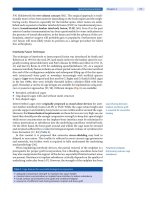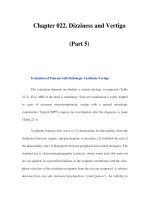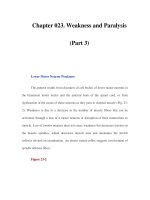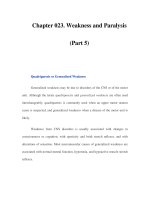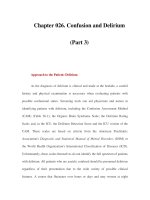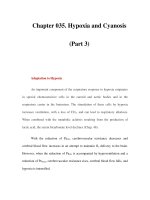Chapter 053. Eczema and Dermatitis (Part 11) ppt
Bạn đang xem bản rút gọn của tài liệu. Xem và tải ngay bản đầy đủ của tài liệu tại đây (14.55 KB, 5 trang )
Chapter 053. Eczema and
Dermatitis
(Part 11)
Dermatophytosis: Treatment
Both topical and systemic therapies may be used to treat dermatophyte
infections. Treatment depends on the site involved and the type of infection.
Topical therapy is generally effective for uncomplicated tinea corporis, tinea
cruris, and limited tinea pedis. It is not effective as a monotherapy for tinea capitis
or onychomycosis. Topical imidazoles, triazoles, and allylamines may be effective
therapies for dermatophyte infections, but nystatin is not active against
dermatophytes. Topicals are generally applied twice daily, and treatment should
continue 1 week beyond clinical resolution of the infection. Tinea pedis often
requires longer treatment courses and frequently relapses. Oral antifungal agents
may be required for recalcitrant tinea pedis or tinea corporis.
Oral antifungal agents are required for dermatophyte infections involving
the hair and nails and for other infections unresponsive to topical therapy. A
fungal etiology should be confirmed by direct microscopic examination or by
culture prior to prescribing oral antifungal agents. All of the oral agents may cause
hepatotoxicity and should not be used in women who are pregnant or breast-
feeding.
Griseofulvin is the only oral agent approved in the United States for
dermatophyte infections involving the skin, hair, or nails. When griseofulvin is
used, a daily dose of 500 mg microsized or 375 mg ultramicrosized griseofulvin
administered with a fatty meal is an adequate dose for most dermatophyte
infections. Higher doses are required for some cases of tinea pedis and tinea
capitis. The usual adult dose of griseofulvin for tinea capitis is 1 g microsized or
0.5 g ultramicrosized given daily. Markedly inflammatory tinea capitis may result
in scarring and hair loss, and systemic or topical glucocorticoids may be helpful in
preventing these sequelae. The duration of therapy may be 2 weeks for
uncomplicated tinea corporis, 8–12 weeks for tinea capitis, or as long as 6–18
months for nail infections. Due to high relapse rates, griseofulvin is seldom used
for nail infections. Common side effects of griseofulvin include gastrointestinal
distress, headache, and urticaria.
Oral itraconazole and terbinafine are approved for onychomycosis.
Itraconazole is given as either continuous daily therapy (200 mg/d) or pulses (200
mg bid for 1 week per month) administered with food. Fingernails require 2
months of continuous therapy or two pulses. Toenails require 3 months of
continuous therapy or three pulses. Itraconazole has the potential for serious
interactions with other drugs requiring the P450 enzyme system for metabolism.
Terbinafine (250 mg/d) is also effective for onychomycosis. Therapy with
terbinafine is continued for 6 weeks for fingernail infections and 12 weeks for
toenail infections. Terbinafine has fewer drug-drug interactions, but caution
should be used when patients are on multiple medications.
Tinea Versicolor
Tinea versicolor is caused by a non-dermatophyte, dimorphic fungus,
Malassezia furfur, a normal inhabitant of the skin. The expression of infection is
promoted by heat and humidity. The typical lesions consist of oval scaly macules,
papules, and patches concentrated on the chest, shoulders, and back but only rarely
on the face or distal extremities. On dark skin, they often appear as
hypopigmented areas, while on light skin, they are slightly erythematous or
hyperpigmented. A KOH preparation from scaling lesions will demonstrate a
confluence of short hyphae and round spores ("spaghetti and meatballs"). Lotions
or shampoos containing sulfur, salicylic acid, or selenium sulfide will clear the
infection if used daily for 1–2 weeks and then weekly thereafter. These
preparations are irritating if left on the skin for more than 10 min; thus, they
should be washed off completely. Treatment with some oral antifungal agents is
also effective, but they do not provide lasting results, and they are not FDA-
approved for this indication. Ketoconazole has been used as a single 400-mg dose;
the patient waits 1 h, exercises to the point of sweating, then lets the skin dry.
Itraconazole and fluconazole have also been used at various doses and frequencies.
Griseofulvin is not effective, and terbenifine is not reliably effective for tinea
versicolor.
Candidiasis
Candidiasis is a fungal infection caused by a related group of yeasts, whose
manifestations may be localized to the skin, or rarely, may be systemic and life-
threatening. The causative organism is usually Candida albicans, but may also be
C. tropicalis, C. parapsilosis, or C. krusei. These organisms are normal
saprophytic inhabitants of the gastrointestinal tract but may overgrow (usually due
to broad-spectrum antibiotic therapy) and cause disease at a number of cutaneous
sites. Other predisposing factors include diabetes mellitus, chronic intertrigo, oral
contraceptive use, and cellular immune deficiency. Candidiasis is a very common
infection in HIV-infected individuals (Chap. 182). The oral cavity is commonly
involved. Lesions may occur on the tongue or buccal mucosa (thrush) and appear
as white plaques (see Fig. 52-12). Microscopic examination of scrapings
demonstrate both pseudohyphae and yeast forms. Fissured, macerated lesions at
the corners of the mouth (perlèche) are often seen in individuals with poorly fitting
dentures and may also be associated with candidal infection. Additionally,
candidal infections have an affinity for sites that are chronically wet and
macerated, including the skin around nails (onycholysis and paronychia) and in
intertriginous areas. Intertriginous lesions are characteristically edematous,
erythematous, and scaly, with scattered "satellite pustules." In males, there is often
involvement of the penis and scrotum as well as the inner aspect of the thighs. In
contrast to dermatophyte infections, candidal infections are frequently painful and
accompanied by a marked inflammatory response. Diagnosis of candidal infection
is based upon the clinical pattern and demonstration of yeast on KOH preparation
or culture.
